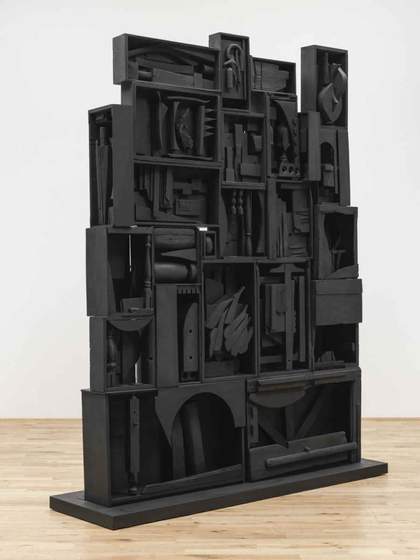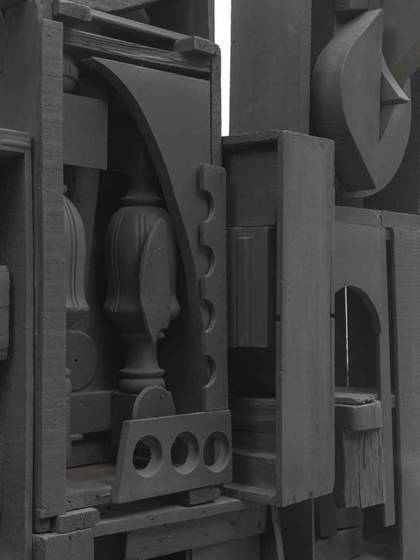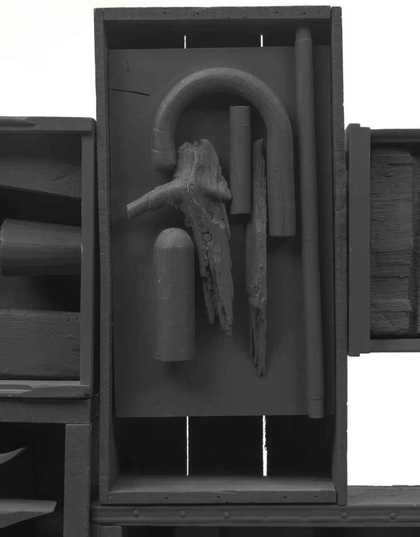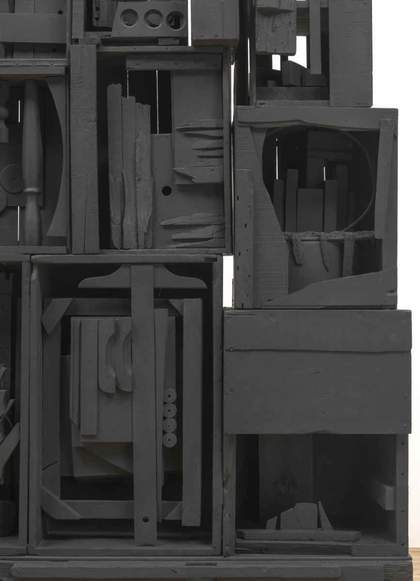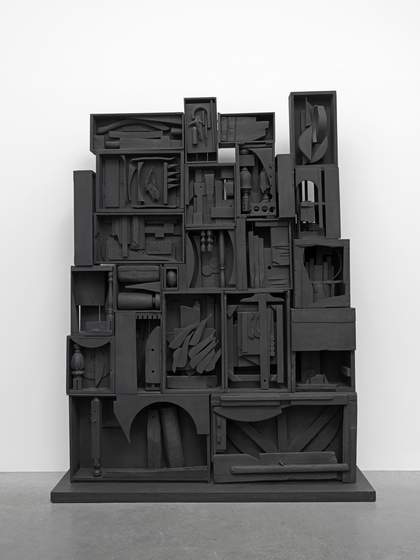
Fig.1
Louise Nevelson
Black Wall 1959
Painted wood
2632 x 2165 x 648mm
Tate T00514
© ARS, NY and DACS, London 2016
Black Wall (Tate T00514; fig.1) is made of twenty-four wooden boxes and crates, each filled with scrap timber elements including joinery offcuts, furniture fragments and other unidentified pieces of timber, all of which are painted black. Many of these pieces exhibit marks of their manufacture, with nails and various woodworking techniques visible beneath the layers of paint, but some elements feature more natural forms. Like a relief sculpture, Black Wall is primarily frontal in orientation, but does include two boxes that are positioned sideways such that their contents remain invisible when the work is viewed straight on (figs.2 and 3). The internal compositions of each box appear jumbled and yet also carefully and intricately arranged. Playing with light and shadow, form and its absence, the twenty-four tableaux transform the detritus of the everyday world into evocative, seemingly abstract forms.
Despite the diverse array of materials used, the all-encompassing black painted finish of Black Wall unifies these disparate, commonplace items into something more mysterious. ‘You take any material and when you convert it to black … it’s so distinguished’, Nevelson explained to one interviewer, adding that she thought this was true not only for sculpture, but for ‘anything’.1 The artist arranged the contents of each of her boxes according to formal intuition – ‘When I begin composing’, she later explained, ‘I know which piece to pick with which other piece’ – while the rough-and-ready finish of her materials was important to her: ‘The dips and cracks and detail fascinate me’.2
In contrast to the careful artistic arrangement of the boxes’ contents, the assembly of the larger wall constructions was, at least initially, less precisely determined. In the case of Black Wall, its component boxes were subject to considerable rearrangement over its early history to the extent that it was treated as a variable construction. Even after it arrived at the Tate Gallery in 1962, the form of Nevelson’s Black Wall was subject to inadvertent variation. For example, the rear panel of one of the boxes was accidentally flipped some time in the mid-1960s, changing the compositional formation of this particular box (fig.4). Although this research project established that the configuration of the lower right-hand box of the sculpture had been altered between 1962 and 1965, Tate conservators determined that rectifying this box risked further damaging the work, and decided that the current arrangement should remain unchanged (fig.5).
Nevelson began using found boxes in her sculpture in late 1957, later connecting the development of this technique to her earlier junk collecting habits in New York: ‘Long before I used such pieces in sculpture, I’d walk on the street, and I’d see something, and I’d bring it home’, she explained. ‘I used to put it on the shelf.’3 One origin story for her so called ‘walls’ is founded on the artist’s recognition that a liquor crate with divisions for bottles ‘was in itself a sculpture’ – a readymade of sorts.4 Another source suggests that it was the discovery of a long box designed to hold rugs on the street that spurred her interest in such readymade forms as the structural basis for her sculpture.5 She claimed that ‘The box at that time was a promise to me’, describing her transformation of such materials into works of art as akin to selling ‘milk crates to millionaires’.6 With this in mind, Nevelson’s use of found objects was a gesture that, at least initially, was borne as much out of thrift as artistic objectives.
Nevelson’s chosen material resonates with the rich cultural associations that wood has earned from its practical uses in everyday life. ‘We have lived with wood through the ages: the furniture in the house, the floors of the house’, she once explained.7 Fragments contained in Nevelson’s boxes sometimes evoke prior uses: at the top of Black Wall a U-shaped curve suggests the handle of an umbrella, while further down a dominant vertical is provided by a wooden yardstick. Several of the larger units at the base of the sculpture appear to be drawers; indeed the British critic Robert Melville thought the work looked like a ‘Welsh dresser for a wizard’s kitchen’.8 Some crates, when seen from the rear, even feature imprinted brand names: one bears the brand of the soft drink manufacturer Cott, while another is imprinted ‘Pouilly Fuisse 1955’, the name of the vintage wine that it once contained. Less legible traces of such marks can be seen on the sides of the sculpture too, where they serve to subtly remind the attentive viewer of the ordinary past of Nevelson’s materials.
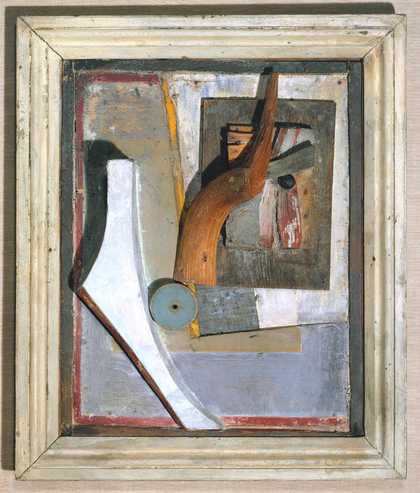
Fig.6
Kurt Schwitters
Relief in Relief c.1942–5
Oil paint on wood and plaster
495 x 413 x 102mm
Tate T01259
© DACS, 2016
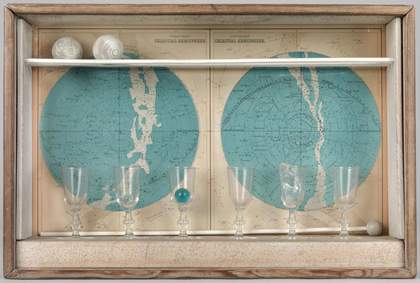
Fig.7 Joseph Cornell
Planet Set, Tête Etoilée, Giuditta Pasta (dédicace) 1950
Glass, crystal, wood and paper
305 x 457 x 102mm
Tate T01846
© The Joseph & Robert Cornell Memorial Foundation/VAGA, New York and DACS, London 2016
Nevelson’s dense accumulations of scrap wood varied strikingly from the mainstream sensibilities of post-war American sculpture, which for the most part favoured compositions of welded metal such as those made by David Smith. Her works instead suggested the ‘Merz’ constructions of the German dada artist Kurt Schwitters (fig.6), or the small-scaled assemblage boxes of the New York-based artist Joseph Cornell (fig.7), both of whom shared Nevelson’s interest in collecting and incorporating found objects into their work. But against the background of New York School painting in the 1950s, Nevelson’s expansive and dense sculptural surfaces also invited comparison with the vast size and drama of abstract expressionist canvases. For dealer and historian Arnold Glimcher, Nevelson’s ‘all-over proliferation of detail’ and ‘feeling of infinite space’ suggested sympathies with the compositions of Jackson Pollock.9 Nevelson herself claimed to have worked in wood because the medium was ‘immediate’ and allowed her to work ‘almost spontaneously’.10 Extending such equivalences with the gestural styles that dominated New York painting at mid-century, the Tate Gallery displayed Black Wall between similarly proportioned works by Franz Kline and Mark Rothko in a 1965 display (fig.8).
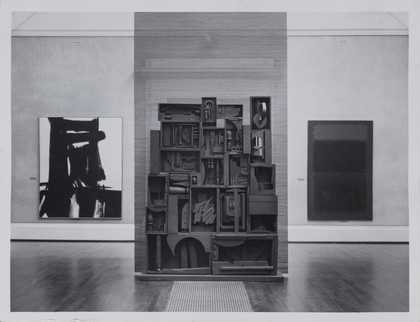
Fig.8
Franz Kline’s Meryon 1960–1, Louise Nevelson’s Black Wall 1959 and Mark Rothko’s Light Red Over Black 1957 at the Tate Gallery in London, c.1965
Unidentified photographer
Louise Nevelson papers. Archives of American Art, Smithsonian Institution
Like the work of Rothko and other painters of the period, Nevelson’s sculptures aspired to establish an altogether more transcendent aesthetic relationship between artwork and beholder, and might even appear to demand the kind of focused attention and bodily presence expected at a religious shrine or other devotional site. ‘My work is not wood; it is only made of wood – it’s got to transcend the material’, she explained to an audience at the Philadelphia Museum of Art in 1961.11 This statement usefully differentiates Nevelson’s transformation of found materials into abstract compositions from the repurposing of junk favoured by neo-dada artists in the late 1950s. Speaking alongside none other than Marcel Duchamp, Nevelson’s modernist commitments were resolute: ‘I am the reverse of Mr Duchamp – optimistic’, continuing:
I believe there is something new under the sun. I feel that when we need new forms they will appear. Abstraction is the form of our time – I am sympathetic – and dying to see what the young people will do in the future. The age in which we’re living is dynamic – artists must be unique. I think this is the richest time in creative history. I believe our art is important – more significant than that in Europe. We are in tune with the sun, the moon, airplanes. We must go ahead – there is no turning back. I think Tintoretto was very nice for his age and our boys are very nice for our age.12
When Nevelson’s work appeared alongside the most promising ‘boys’ in the Museum of Modern Art’s Sixteen Americans exhibition in 1959 her scrap materials would have certainly chimed with the combines of Robert Rauschenberg (fig.9), but one could have equally aligned her dense geometric monochromes with the black paintings of Frank Stella that were also on display (fig.10), although Nevelson’s own contribution to the exhibition was a new series of works painted white. Still, the capacity for works such as Black Wall to be viewed as variable installations seems to pre-empt the repetitive and modular character of 1960s minimalism. Nevelson’s sculptures might have been made from the mundane scraps of the recent past, but her faith in the triumph of abstraction and the progress of the avant-garde evident in the above passage is aligned both with modern technology and with the eternal cycles of nature. Elsewhere, Nevelson’s autobiographical self-fashioning could draw liberally on her Russian heritage, or her encounters with ancient and primitive art forms, but it was modernism with which she most forcefully identified her art.
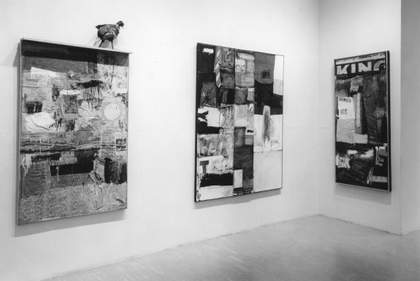
Fig.9
Installation view of Robert Rauschenberg works in ‘16 Americans’
The Museum of Modern Art, New York, 16 December 1959 – 17 February 1960
Photo: © 2013 Estate of Rudy Burckhardt/Artists Rights Society (ARS), New York

Fig.10
Installation view of Frank Stella works in ‘16 Americans’
The Museum of Modern Art, New York, 16 December 1959 – 17 February 1960
The Museum of Modern Art Photographic Archive, The Museum of Modern Art Archives
Photo © Soichi Sunami
Born Louise Berliawsky in Kiev, Nevelson migrated to the United States with her family in 1905 as a child. They settled in Rockford, Maine, where her father ran a lumberyard – a prescient detail invariably included in biographies of the artist. In 1920 she moved to New York with her husband Charles Nevelson, and began her artistic studies at the Art Students League in New York. In 1931 Nevelson separated from her husband and moved to Munich to study with painter and teacher Hans Hofmann, returning to New York the following year. By the 1940s she began to concentrate on sculpture, and worked briefly as an assistant to the Mexican muralist Diego Rivera, who encouraged her interest in pre-Columbian sculpture, the influence of which is detectable in her early three-dimensional works in clay. Nevelson exhibited at the Nierdendorf Gallery and in a range of group shows – including Peggy Guggenheim’s important 31 Women exhibition at her Art of this Century gallery in 1943 – and maintained active involvement in the New York art scene, although it was not until the late 1950s that her work became the subject of significant critical attention.
In 1945 Nevelson moved to a house and studio in Kips Bay, a neighbourhood on the east side of midtown Manhattan. She remained there until late 1958 or early 1959, and it was here that she developed the sculptural walls with which she would rapidly find international prominence. Her breakthrough exhibition was Moon Garden Plus One at Grand Central Moderns Gallery in 1958. For this show Nevelson filled the gallery with 116 boxes of the sort used in Black Wall, displayed not as distinct sculptures but as one continuous and dramatically lit environment consuming the entire gallery space – an early example of what would eventually become known as installation art.13 A 1958 feature in Life magazine showed the artist amid this ‘eerie world’, tinted green and wearing a pointed hat, as if to cast Nevelson’s act of creation as a kind of artistic witchery. The following year Nevelson won the sculpture prize at the Art USA 1959 exhibition at the New York Coliseum, judged by Lloyd Goodrich, Charles Cunningham and Clement Greenberg, and shared the Art Institute of Chicago’s Logan Medal with fellow New York sculptor Isamu Noguchi.14 In just a few years, Nevelson emerged as a major figure in American sculpture.
By the time Black Wall entered Tate’s collection in 1962 Nevelson had been announced as the United States’ representative for that year’s Venice Biennale. As critic Annette Michelson reported, it was an award that marked ‘the consecration of a reputation that has been snowballing on the Continent ever since Mrs Nevelson’s first Paris exhibition in November 1960’.15 Tate had been interested in Nevelson’s work since at least November 1961.16 After seeing other works on a trip to the United States, Tate curator Norman Reid suggested Black Wall as a possible purchase for the American Friends of the Tate Gallery, a group founded in 1960.17 Reid would have seen the work at the Hanover Gallery in London in mid-1961, where, according to Reid, the work had ‘been much admired by a number of Trustees and Friends’.18 With the gallery warning that ‘an American buyer’ had also expressed interest in the sculpture, the work was put on hold for three weeks.19 Tate’s trustees agreed to accept the gift of Black Wall in May 1962, but as the American Friends of the Tate struggled with changes to American tax regulations, the costs of the work were eventually met by the UK-based Friends of the Tate.20
In the decades after Black Wall was made, Nevelson’s image tended to overshadow her achievements as a sculptor. Her theatrical dress and often inscrutably mystical artistic statements could obscure her important position within the post-war avant-garde, emphasising the decorative qualities and idiosyncratic style of her work at the expense of its widespread influence and relevance. Certainly, the capacity for Nevelson’s art to straddle apparently dissimilar tendencies – cubism and surrealism, neo-dada junk construction and minimalist modularity – has contributed to her unstable position in the post-war canon. Further destabilising her status, Nevelson herself discouraged enquiry into her position within a broader artistic scene: ‘I don’t know anything about what other people are doing’, she claimed in 1959, denying that any artists ‘past or present’ had influenced her.21 But when Nevelson also told the same interviewer that she did not ‘think you can pigeon hole things to any movement’, she also indicated the capacity for her own pigeon holed constructions to productively confuse the artistic categories into which the post-war avant-garde had, even then, begun to be sorted.22

